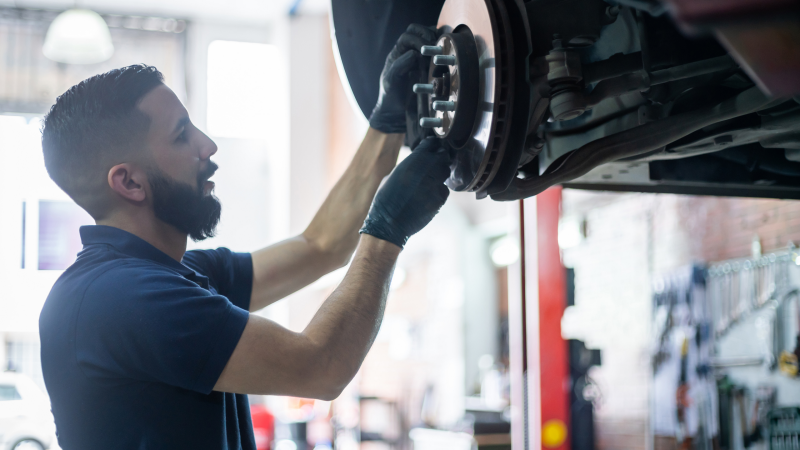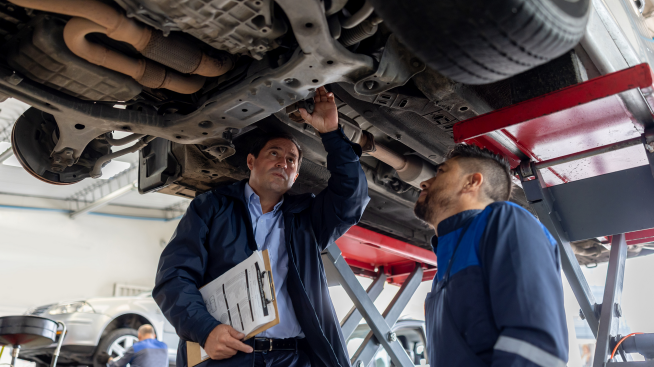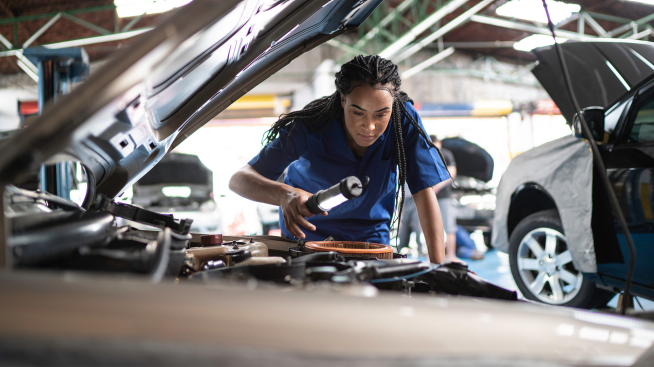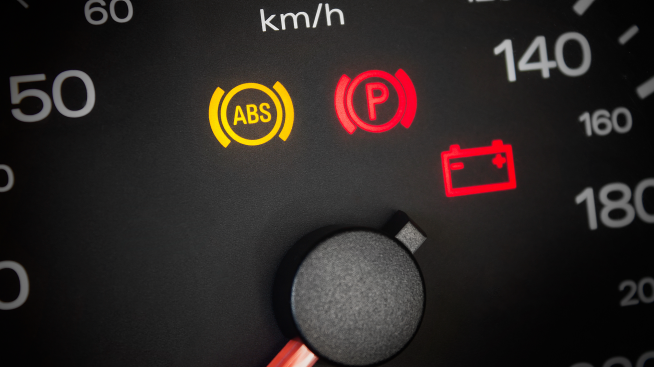Brake pads: Maintenance and more

When people think about driving, they think about being on the move. An equally important aspect, however, is stopping. That’s where your brake pads come in — helping you slow your car down or bring it to a stop with just a light press of the brake pedal. Brake pads are a crucial component of your car’s braking system. Ineffective brake pads can decrease your stopping power, which is dangerous for you and other motorists. As a car owner, it may be helpful to understand some basics about your brakes, including some maintenance basics. Let’s dive in!
Brake basics
At its core, braking is all about turning kinetic energy (motion) into thermal energy (heat). This is achieved by applying friction to the wheels in some way. If you’ve ever ridden a bicycle, you’re likely already familiar with a basic brake system. You activate the brakes via the handlebars, and cables transfer that clamping motion to the brakes on your wheels. These clamps then slow down your wheels using friction. The same basic principles apply when you step on the brake pedal in your car.
Disc brakes vs. drum brakes
There are two main types of car braking mechanisms to be aware of: disc brakes and drum brakes. Disc brakes are more commonly used today, but before those, most cars had drum brakes.
Drum brakes were named as such because their components are placed inside a metal drum that rotates with your wheels. Inside the drum was a set of brake shoes, which pressed on the wheel to slow down the car. Unfortunately, this design suffered from one major flaw. Under stressful braking conditions (such as descending a steep hill), the brakes would lose effectiveness. Remember how brakes work by turning kinetic energy into thermal energy? Under high braking stress, drum brakes could sometimes get too hot to function effectively.
Disc brakes utilize a metal rotor and caliper to halt the wheels. Disc brakes avoid overheating by eliminating the drum and keeping everything fully exposed to avoid overheating.
Let’s take a closer look at some important parts of modern disc brakes:
- Rotor: The rotor is a metal disc (often made of cast iron or steel) that’s attached to the wheels and turns with them. When you hit the brakes, the calipers clamp onto these rotors. That, in turn, slows your wheels down.
- Calipers: Calipers are essentially the “clamps” that create the friction required to slow your car down. When you press your brake pedal, pressurized brake fluid pushes on pistons inside the caliper. This c-shaped clamp then presses down on the rotor to slow you down.
- Brake pads: Calipers might be the physical clamps on the rotor, but it’s your brake pads that actually make contact with the rotor. Brake pads are bonded to the inside of your calipers and are responsible for generating the actual friction required to stop the car.
Now that you understand the mechanics of brakes, it’s time to learn about different sounds they could make, and when it might be time to consult a professional.
Why do brakes squeak and make noises
Many drivers may know that all-too-familiar sound of squeaky brakes. That’s because brake pads eventually wear down over time as they grind up against the rotor when you stop or slow down. Squeaking and other sounds your brakes make can help indicate that it’s time for a tune-up. Here’s a guide to a few of the most common brake noises and what they might mean:
Squeaking and squealing
A squeaking sound coming from your brakes is typically indicative of worn brake pads. Some pads come with a set of metal tabs built into them that become exposed as the pad material wears down. This indicates that it’s time to get your brake pads replaced. Over time, these tabs can rub up against your rotor to produce a squeaking, squealing sound — an audible reminder to have a mechanic inspect your brake pads and replace them if needed.
Grinding
A grinding sound often indicates that you’ve progressed past “worn” brake pads to “worn out” brake pads. Metal is now grinding against metal every time you hit the brakes, which can be very dangerous and cause serious damage to your rotors and wheels. It's best to head to a mechanic and get your brake pads replaced without delay.
Thumping
A thumping sound while braking, often rhythmic in nature, could indicate that your rotors have warped or gone out of shape. These sounds come from your brake pads pressing down on and bumping up against the uneven rotor surface. On occasion, this sound may instead be caused by a buildup of worn brake pad material on the rotor. This buildup produces a similar effect of roughing up the shape of the rotor, without actually warping it. Luckily, pad buildup can be cleaned off by a mechanic without having to replace the rotor altogether (which is what you’d have to do in the event of warping).
Brake pad maintenance: How long do brake pads last?
The lifespan of your brake pads is typically somewhere in the tens of thousands of miles, although aggressive driving patterns or regular exposure to stop-and-go traffic could speed up this timeline.
Worn brake pads can make it harder to stop within a reasonable distance, which is a significant risk to you and others. Worn-out brake pads are even more dangerous and will damage your brake system too. For those reasons, it’s helpful to have your brakes inspected on a somewhat regular basis. Consult with your manufacturer to see what type of maintenance schedule is recommended for your specific vehicle. Typically, it's every few months or every few thousand miles.
In summary
You know how they say the squeaky wheel gets the grease? Your brake pads are a little like that too. If your brakes are making noises, it’s likely indicative of worn brake pads that need servicing, so you’ll want to consult with a trusted, certified mechanic to diagnose and make any required repairs.



